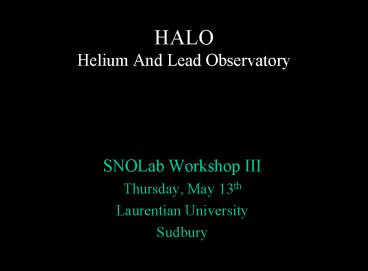HALO Helium And Lead Observatory - PowerPoint PPT Presentation
1 / 20
Title:
HALO Helium And Lead Observatory
Description:
Peter Doe, Charles Duba, Joe Formaggio, Hamish Robertson, John Wilkerson. Laurentian University ... Cliff Hargrove, David Sinclair. Queen's University. Fraser ... – PowerPoint PPT presentation
Number of Views:26
Avg rating:3.0/5.0
Title: HALO Helium And Lead Observatory
1
HALOHelium And Lead Observatory
- SNOLab Workshop III
- Thursday, May 13th
- Laurentian University
- Sudbury
2
Overview
- HALO Description and (history)
- Supernovae, Neutrinos and Lead
- Neutrons and NCDs
- Simulations
- Signal and Backgrounds
- Budget
- Conclusion
3
HALO?A low-cost supernova detector
- HALO Phase I
- 90 Tons of lead
- From Deep River Cosmic Ray Station, c. 1960
- 200m surplus SNO proportional counters (NCD)
- Moderator
- Reflectors
- Electronics
- Computer
4
100kg Lead Bricks from muon counters
5
Neutrinos from supernovae
- Neutrinos leaving star are expected to be in a
Fermi-Dirac distribution according to escape
depth - Oscillations redistribute neutrino temperatures
- SK, Kamland are primarily sensitive to ?e
6
Expected signal from Supernova Neutrinos
- In 90 tons of lead for a SN _at_ 10kpc,
- Assuming LMA, FD distribution around T8 MeV for
?µs, ?ts. - 76 neutrons through ?e charged current channels
- 34 single neutrons
- 21 double neutrons (42 total)
- 24 Neutrons through ?x neutral current channels
- 10 single neutrons
- 7 double neutrons (14 total)
- 100 neutrons liberated
- Engel, McLaughlin, Volpe, Phys. Rev. D 67,
013005 (2003)
7
Neutron spectrum in lead
8
HALO Monte CarloWork done by F. Fleurot and J.
Massicotte
- Determines neutron detection efficiency
- Uses GEANT4
- Explores various detector geometries
- Optimizes moderator thickness
- Sets minimum reflector thickness
9
Two sample geometries
10
(No Transcript)
11
(No Transcript)
12
(No Transcript)
13
NCD Energy Spectrum
764-keV peak
Energy spectrum from one NCD string with an AmBe
neutron source.
191-keV shoulder from proton going into the wall
14
Energy vs Duration
15
Signal Summary
16
HALO Backgrounds
- Norite (a,n) neutrons
- 0.1(e) Hz
- Internal alphas in n-region
- 3.5x10-4 HzLength/200m
- Cosmic ray neutrons
- 1.3x10-5(e) Hz
- Multi-neutron bursts thermalize in 200ms
- Gamma Backgrounds
- lt 1x10-5 Hz
17
SNOLAB Requirements
- 3x3x3m cube for optimum efficiency
- Other configurations are possible
- Hallway would be optimum for future expansions
- Overhead crane for setup and movement
- UPS power and remote access for 100 livetime
- Earliest possible start date
18
(No Transcript)
19
Summary
- HALO is ready to assemble
- Most materials already in Sudbury
- Most hardware already tested and characterized
- Small, adjustable footprint
- Provides information about SN neutrino spectra
- Can easily work with SNEWS for SN watch
- Is readily expandable (new materials/methods)
- Long-term low-upkeep project
- HALO is ready to assemble
- Most materials already in Sudbury
- Most hardware already tested and characterized
- Small, adjustable footprint
- Provides information about SN neutrino spectra
- Can easily work with SNEWS for SN watch
- Is readily expandable (new materials/methods)
- Long-term low-upkeep project
20
Collaboration Members as of 5/04
- University of Washingon
- Peter Doe, Charles Duba, Joe Formaggio, Hamish
Robertson, John Wilkerson - Laurentian University
- Jacques Farine, Clarence Virtue, Fabrice Fleurot,
Doug Hallman, Steven Rayan - Los Alamos National Laboratory
- Jaret Heise, Andrew Hime
- Lawrence Berkeley National Laboratory
- Kevin Lesko
- Carleton University
- Cliff Hargrove, David Sinclair
- Queens University
- Fraser Duncan, Tony Noble































